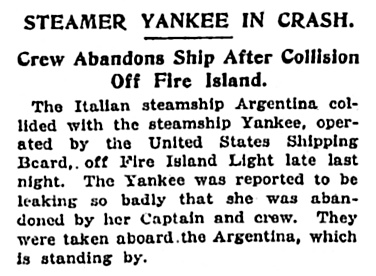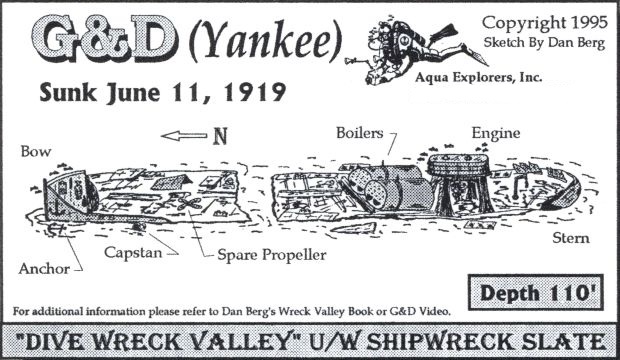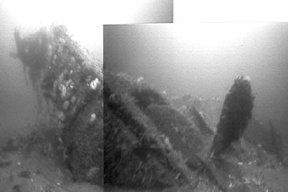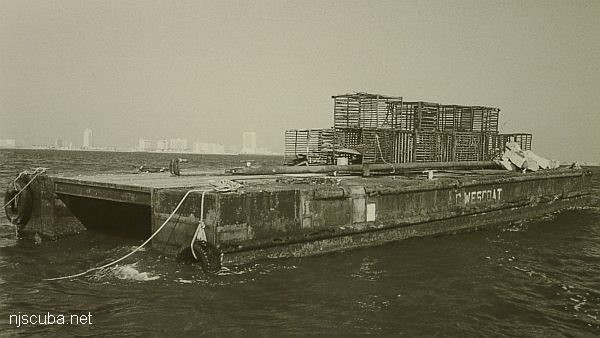Yankee (G&D)

- Type:
- shipwreck, Great Lakes freighter, USA
- Built:
- 1890, AmShip Cleveland, Cleveland OH USA, as German
- Specs:
- ( 296 x 40 ft ) 2418 gross tons, 30 passengers & crew
- Sunk:
- Wednesday June 11, 1919
collision with liner Argentina - no casualties - Depth:
- 110 ft

The bow is intact and lists to one side, facing north. This provides the most dramatic relief, rising some 20 ft off the bottom. The boilers are still visible and sit upright. The stern is pretty broken up and has little relief. "G&D" stands for "Gloria & Doris".

Yankee


This wreck had been unidentified for many years. She was originally found and named by a charter boat captain. He named the wreck after two girls that were on his boat that day, Gloria and Doris. The name stuck, and even today, nautical charts refer to the wreck as the G&D. In the original Wreck Valley book, I wrote the G&D Wreck was most likely a vessel named Durley Chine. This assumption was proven wrong when diver, Rick Jaszyn, found a bell with the name Durley Chine on another previously unidentified wreck known as Bacardi. The true identity of the G&D wreck is still waiting for some lucky diver to find a piece of the puzzle that allows us to identify her.
The G&D lies 21 miles out of Jones Inlet in 110 feet of water. Her boilers are still standing upright, her intact bow leaning on its side. Her beams and ribbing rise out of the sand, leaving no trace of the form they once held. The wreck is a haven for huge lobsters, cod, ling, and Blackfish. I have seen everything from giant ocean sunfish, dolphins, and turtles to seahorses at this site. For divers and fishermen alike, she is considered to be one of the best wrecks in the area.
IDENTIFICATION
Aqua Explorers Inc., is proud to announce the positive identification of a wreck previously known as the G&D. At the same time, Aqua Explorers is releasing its Dive Wreck Valley G&D video detailing the wreck's history, identification, and present condition.
During the summer of 1995 Dan Berg producer of the Dive Wreck Valley television series filmed underwater sequences for an upcoming G&D show. The show utilized Captain John Lachenmayer's dive boat Sea Hawk. After the dive, John explained how he had recently recovered a dish embossed with a steamship company flag. He had hoped that the dish would lead to the steamship companies identity. With this information, he could check records to see what vessels from that company had gone down off Long Island. He went on to explain that he had already contacted maritime museums the Steamship Historical Society as well as a few authors of shipwreck books. None could find any information regarding the flags company.
Dan Berg, author of the popular Wreck Valley book about shipwrecks off Long Island and New Jersey, went to work. He wrote a few letters to England as well as to Marine Historians here in the states. Within only a few days he had hit the jackpot. Marine historian Bill Schell from Massachusetts not only identified the vessel's steamship company but reported a near positive identification on the wreck. The Flag belonged to the United States Steel Corp., Pittsburgh Steamship Division based in Cleveland, Ohio. The companies entire fleet sailed exclusively on the Great Lakes. It seems that during WWI five vessels were cut in half, brought out of the Great Lakes then reconstructed and transferred to the East coast for the coal trade.
Of these five vessels, four were whaleback barges with no engine. Only one vessel, the Yankee, fits the description of the wreck we know as the G&D. The Yankee was a 296 foot by 40 foot steel-hulled Great Lakes steamer. She was built by Globe Iron Works in December 1890 and was originally named German. The Yankee displaced 2,418 gross tons and was powered by coal-fired steam.
On the night of June 11, 1919, while en route from Norfolk, Virginia to Boston, Massachusetts, carrying a cargo of coal, the Yankee entered a dense fog. Soon after she collided with the Italian liner Argentina. The Argentina's propeller ripped through, causing a fatal wound to the steamer Yankee. The following information is excerpted from the accident report filed with the Secretary of Commerce: "A dense fog prevailed and the vessel was proceeding at a slow speed ... Suddenly, the lights of the Argentina were seen about two points on the port bow ... Engines of the Yankee were at once stopped but as it was seen that a collision was inevitable, the helm of the Yankee was brought hard-a-port". This was done in an effort of paralleling the other vessel and was almost accomplished, but the ships closed in, and the starboard bow of the Argentina struck then sheared off the Yankee. This forced the Argentina's stern into the Yankee's hull. The Argentina's propeller ripped through, causing a fatal wound to the steamer Yankee. Captain Dennis Mugan, his entire crew of 22, and all eight passengers abandoned ship without injury.

Today the wreck sits in 110 feet of water, 21 miles off Jones Inlet, Long Island., NY. Her engine and boilers are upright while her bow leans slightly to her port side. This wreck is one of the most productive lobster dives in the area. Captain John's discovery of a dish had lead to the wreck's identification. The only problem now is that only a few miles away is another unidentified wreck which everyone always believed to be the Yankee. Maybe John and Dan will get lucky and recover another key artifact from an area known as Wreck Valley.
Excerpted from Wreck Valley CDROM by Dan Berg


Questions or Inquiries?
Just want to say Hello? Sign the .